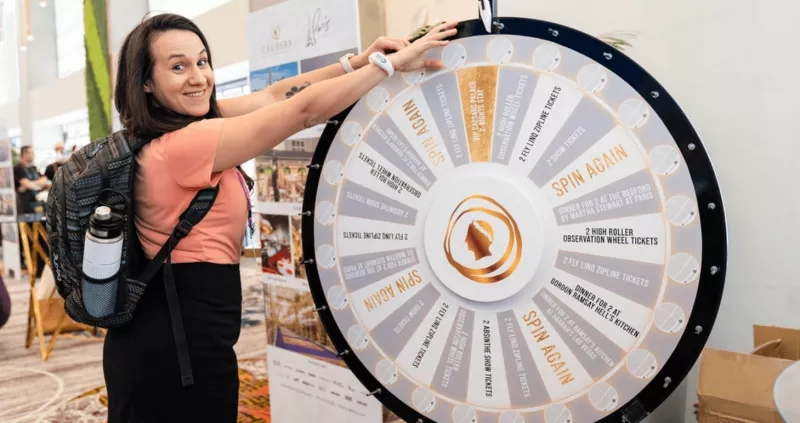Planning trade shows can be daunting. Not only is there the typical stress of planning an event, but you must also be hyper-focused on the return on investment (ROI) of your marketing and sales efforts during the show.
The trade show industry was set to reach an estimated $15.8 billion in 2024, which means organizations know the value of these events and are investing heavily in them. Of course, it’s necessary to prove that value after each trade show, and to do that, you’ll need a comprehensive and effective trade show strategy, complete with a trade show planning template, to help you see it through.
To help you on your way, we’ve put together a trade show checklist, from pre-show planning to post-show follow-up. Think of this as an event planning guide to all the tools and strategies needed to make your next trade show a resounding success.
Pre-show: Planning an effective trade show
Developing and planning an effective trade show begins long before the day of the event. Whether you’re organizing an entire trade show or are an exhibitor, the following trade show checklist templates can help you set the stage for success in this first phase of your planning.
Pre-show checklist for trade show exhibitors
A trade show exhibitor checklist serves as a roadmap for your corporate event planning, ensuring nothing essential is accidentally overlooked. By following a well-structured event management plan, exhibitors can focus on engaging with attendees, generating leads, and maximizing their return on investment during the event.
Below is a complete pre-show checklist for trade show exhibitors:.
Trade show planning resources
- Use trade show software to maximize efforts from the start
- Planning team staff assignments
- Set trade show planning deadlines
Event goals and KPIs
- Set event objectives and trade show ROI goals
- Establish measurable key performance indicators (KPIs)
- Identify the target audience
Trade show budget
- Establish total trade show budget, generally broken down as follows:
- Booth space and design
- Travel, staffing, and logistics
- Marketing and promotion
Trade show booth aesthetic and strategy
- Select booth location and size
- Plan booth design and construction (including carpeting, furniture, and décor)
- Essential booth supplies (including common office supplies)
- Marketing, promotion, and networking materials (business cards, brochures, giveaways)
- Necessary technology and materials for demonstrations and engagement
Marketing and promotion strategy
- Build event marketing campaigns to promote your presence at the trade show
- Establish your trade show lead generation strategy
- Set up your trade show software for efficient lead capture and reporting
- Use event marketing software to manage your marketing and lead data
Book appointments and networking opportunities
- Schedule appointments for one-on-one meetings
- Add networking events to your schedule
- Schedule dinners and meetings with known prospects and leads in nurture
Travel and accommodations
- Book travel and accommodations for event staff
- Plan for local transportation options and costs for staff
Booth staff training
- Determine which staff will be most valuable as booth/brand representatives
- Train staff on managing booth logistics, technology, and promotion tactics
Setup and materials logistics
- Rental, shipping, and handling of all booth design elements (furniture, carpeting, tech)
- Materials storage plan, including location, handling, and fees
- Setup and teardown plan, including designated staff, loading times, etc.
- Vendors for booth equipment requiring expert assembly
Pre-show checklist for trade show organizers
If you’re the event organizer, your trade show planning checklist is going to look much more complex than when you’re an exhibitor. You’ll still need to check off the same items as exhibitors, as you’ll have your own booth at your trade show as well, but you’ll also need to consider several more elements.
Below is a complete pre-show checklist for trade show organizers.
Trade show planning resources
- Use event management software to build your event
- Planning team staff assignments or a contracted event coordinator
- Choose event date options
- Set trade show planning timeline and deadlines
Event goals and KPIs
- Set event objectives and trade show ROI goals
- Establish measurable key performance indicators (KPIs)
- Identify the target audience
Trade show budget
- Event budget management software
- Establish total trade show budget, and allocate percentages for each expense category
Event venue and vendors
- Search for venues using a venue sourcing tool
- Search the vendor marketplace for event vendors
- Send requests for proposals (RFPs) to suppliers and negotiate contracts
- Finalize event dates based on the selected venue
- Create an exhibit floor layout using a trade show booth management tool
- Design spaces for sessions and onsite activities using event diagramming software
Content and engagement planning
- Research industry and event trends to establish relevant event themes and topics
- Recruit event sponsors, exhibitors, and speakers
- Enhance partners’ experience with exhibitor management software
- Request abstracts and arrange session content with speaker management software
- Plan engagement activities (networking, meals, entertainment, etc.)
- Use an attendee engagement platform with engagement scoring software
Marketing and promotion strategy
- Create a website and implement event registration software
- Build event marketing campaigns
- Use event marketing software to manage event planning and marketing in one place
- Establish your trade show lead generation strategy
Trade show booth aesthetic and strategy
- Trade show booth design and construction plan (including carpeting, furniture, etc.)
- Essential booth supplies (including common office supplies)
- Marketing, promotion, and networking materials (business cards, brochures, giveaways)
- Necessary technology and materials for demonstrations and engagement
Book appointments and networking opportunities
- Use appointment scheduling software to plan one-on-one meetings
- Schedule time for networking events, client and partner dinners, VIP meetings, etc.
Travel and accommodations
- Hotel room blocks for attendees, speakers, exhibitors, and sponsors
- Book travel for staff, VIPs, and other stakeholders
- Plan for local transportation options (hired shuttles, public transportation, bus tours)
Staff training and security measures
- Train staff for designated roles (managing your booth, registration desk, and attendee support)
- Train all staff, suppliers, and venue partners on event safety protocols
Setup and materials logistics
- Shipping and handling of all event design elements (stages, booth materials, marketing materials, etc.)
- Materials storage plan, including location, handling, and fees
- Setup and teardown plan for all exhibitors and sponsors
- Vendors for equipment requiring expert assembly (technology, staging, lights, etc.)
During the show: Booth set-up and networking
Once you’re live on the trade show floor, focus shifts to execution and engagement. Let’s look at essential elements to consider on the day of the event, ranging from setting up your booth to engaging with event attendees.
Once again, we’ve created checklists for two scenarios: organizing a trade show and attending as an exhibitor.
Day-of-event checklist for trade show exhibitors
When the day of the trade show arrives, you’ll have many moving parts to manage, in addition to trying to make the most of the event as an attendee. Here’s a day-of-event checklist for trade show exhibitors.
Vendor booth checklist
- Booth setup: Ensure your booth furniture, carpeting, tech, etc. all arrive on time and are set up to your specifications.
- Booth aesthetic: Set up any booth décor, displays, banners, and branding materials to create a visually appealing setup.
- Marketing and sales collateral: Unpack and set up product samples, brochures, business cards, swag, and any other marketing and sales materials.
Booth visitor engagement checklist
- Lead generation tech: Set up yourlead capture software for efficient lead tracking, post-show nurture, and reporting.
- Staff preparedness: Ensure all booth staff are prepared with key messaging, product details, engagement strategies, FAQs, and proper attire.
- Engagement tactics: Incorporate interactive elements in your booth experience, such as live demos, gamification, contests, social media engagement, and swag giveaways.
Networking checklist
- Appointments scheduling tech: Make sure your booth staff have downloaded the event’s mobile app so they can schedule appointments with prospects that work with their event agenda.
- Take every networking opportunity: Add any planned networking events to your staff’s schedules, including breakout meetings, mingling events, after-hours events, and scheduled cocktail hours or dinners.
- Balance relationships: While your staff will need to balance engaging with new prospects and existing partners, make sure everyone is focusing their efforts in the most productive direction. If that means taking a prospect to lunch and meeting a long-standing client for dinner, great!
Day-of-event checklist for trade show organizers
If you’re organizing a trade show, use the checklist above as a starting point, and build from there. In addition to your experience as an exhibitor at your trade show, you’ll also need to consider factors related to executing your entire event, not just what’s happening on the exhibit floor.
Vendors, exhibitors, and speakers' checklist
- Logistics management: Ensure all vendors, exhibitors, and speakers have what they need to participate successfully in your event. This includes coordinating booth setup and teardown, loading-in and loading-out procedures at your venue, and checking that your vendors are ready to roll.
- Speaker preparedness: Check in with your speakers to be sure they’ve arrived at your location and will be able to make their speaking commitments (and that their content is fully prepared). Ideally, your speakers will arrive in advance of the event to rehearse.
- Onsite security: Ensure your event security vendors or processes are in place and that all staff are ready to execute event safety protocols.
Attendee arrival checklist
- Registration desk: Manage the flow of onsite registrations and check-ins with the help of onsite event software.
- Badge distribution: Make the badging process seamless with on-demand badge printing at check-in kiosks or tablets.
Bonus: Use your event badges to track attendee engagement throughout your event by placing badge scanners at exhibitor booths and outside of session rooms, or by leveraging passive RFID technology for a less obtrusive experience.
Attendee engagement checklist
- Hired entertainment: Be sure you’ve checked in with any hired entertainment, such as stage acts, artists, or tour services, to confirm their timetables.
- Interactive displays and activities: Set up and manage any interactive displays, such as virtual reality (VR) experiences, interactive art installations, photo booths, or social media live stream setups.
- Offsite activities: Confirm transportation, headcounts, and logistics for offsite activities such as local tours, dinners, networking, etc.
Food and beverage checklist
- Catering and serving staff: Be sure you have the necessary staff available to ensure a smooth experience whenever meals or refreshments are served.
- Banquets, award dinners, and VIP meals: These important meals are events in themselves, and you’ll need to confirm every detail to ensure they’re pulled off with the level of luxury you’re hoping to achieve.
- Exhibit floor refreshments: From the layout of refreshment tables to the timing of snacks for when the trade show will be at its busiest, make sure your exhibitor floor F&B plan is locked down on the day.
- Intermittent refreshments: Don’t forget the coffee! Throughout the event, be sure you’re offering attendees water, coffee, and light bites to keep them energized and hydrated. Exhaustion is the enemy of trade shows, so do all you can to keep attendees on their feet, visiting booths, and tuning into your conference content.
Post-show: Following up with Leads
The work doesn’t stop once the trade show ends. Once the booths have been dismantled, the venue has closed, and your staff has gone home, you’ll need a strong follow-up strategy to convert leads into opportunities.
Post-event trade show checklist
Whether you’re an exhibitor or the trade show organizer, your post-event checklist will look much the same. As the host, you’ll have a bit more information to report to stakeholders, but the stakes are the same: proving your trade show ROI.
Lead data and other KPI analysis
- Lead quality and metrics: Determine the number of leads you captured during the event and build a strategy for following up based on the quality of each lead.
- Analyze event data: All data available to you has value in helping you determine your event ROI. From booth visitors to scheduled appointments, every detail paints a picture of how the trade show worked for you and can be used as a KPI.
- Social media activity: Analyze the online activity across your social media platforms, looking for insights into audience sentiment, increased brand awareness, improved brand image, etc.
Attendee feedback and follow-up
- Collect post-event feedback: Use event survey software to collect feedback directly from attendees and booth visitors regarding attendee sentiment, satisfaction, and overall experience feedback.
- Follow up with leads: For every fresh lead, make sure you follow up using email campaigns, social media, and any other lead-nurturing tactics in your marketing arsenal.
- Nurture relationships: If you met with longstanding partners or newer clients, be sure you follow up with each of them to keep the conversation going and maintain the relationship beyond the event.
Event ROI reporting
- Track lead conversion rates: As you follow up with leads generated at the trade show, make sure you’re tracking conversion rates for these leads separately from leads generated elsewhere. These will be key metrics used to establish your trade show ROI.
- Curate event data: Using event reporting tools, combine your data and analysis to demonstrate your event's total ROI.
- Event debrief: Report on your findings during an event debrief, and use your insights to build your strategy for future events, enhance your event planning skills, and bring your team together to celebrate your wins.
Now you’re ready to take on trade shows
Navigating a trade show successfully requires a blend of strategic planning, effective execution, and data-driven follow-up. Using these checklists and event planning tips as your guide, you’ll be sure to account for every detail, from engaging attendees and capturing leads to evaluating ROI and adjusting your strategy for the next trade show.
Frequently asked questions
What should I have at my trade show booth?
An effective trade show booth has eye-catching displays, promotional materials, and branded giveaways, digital lead capture tools, interactive elements, product demonstrations, and well-trained staff who can attract visitors and drive engagement with your products and services.
How do you prepare for a trade show?
Prepare for a trade show by following a trade show planning checklist to organize your tasks and ensure you aren’t missing any steps. You’ll need to consider all elements, from your trade show budget and marketing strategy to onsite logistics and travel.
How do you set up a trade show table?
Set up a trade show table by incorporating branded elements, promotional materials, display items, and swag to attract booth visitors, and lively demonstrations that catch the eye.








